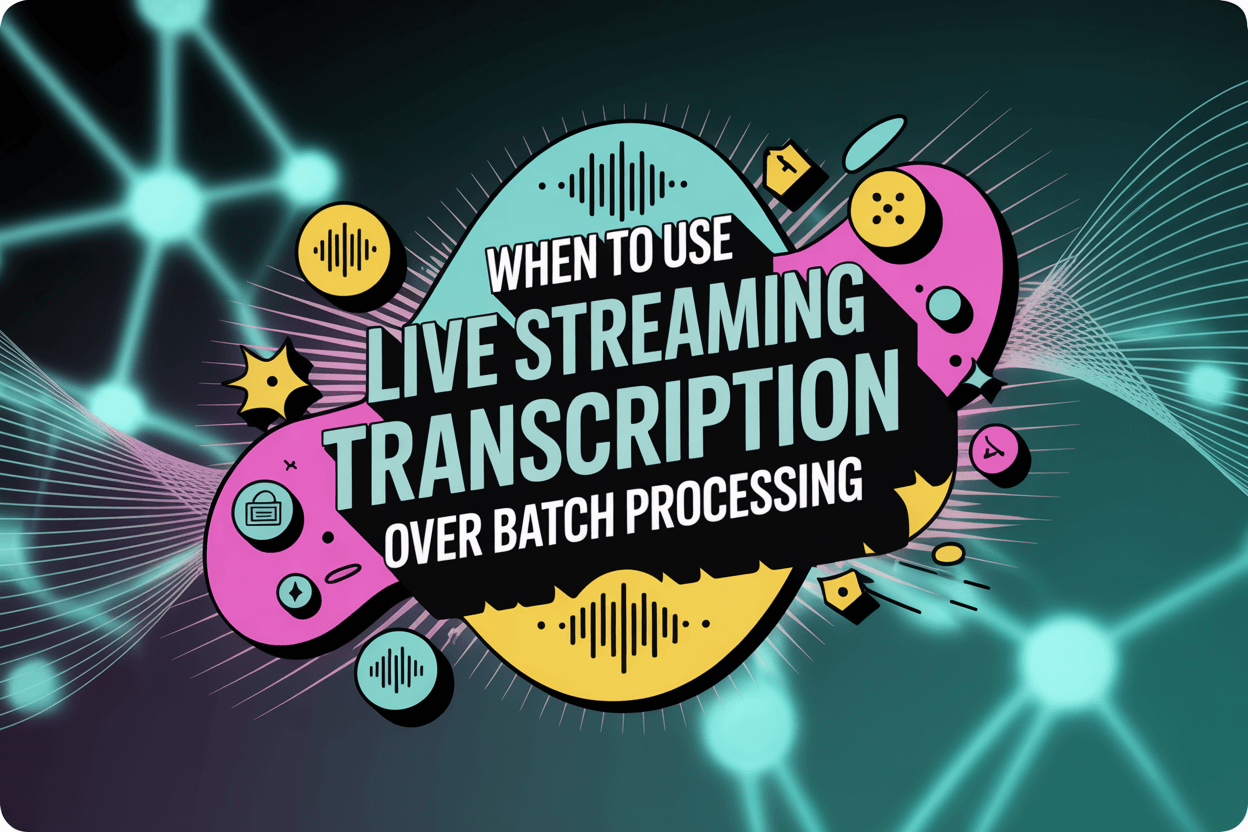您應該使用 即時串流轉錄 當您需要即時輸出文字時 - 例如,在即時會議、網路研討會或廣播期間。. 批次處理轉錄, 另一方面,預錄檔案最適合在事件發生後進行處理。正確的選擇取決於您是否重視 即時存取 或 活動後準確性.

⚡什麼是即時串流轉錄?
即時串流轉錄 可在說話的同時將語言轉換成文字。它使用 即時語音辨識模型 可在數秒內擷取、處理並顯示文字。當參與者或觀眾需要即時字幕或註解時,這一功能尤其有用。.
常見使用個案
- 即時網路研討會與虛擬活動
- 線上教育與講座
- 即時客戶支援電話
- 即時無障礙字幕
即時轉錄有助於團隊保持參與並即時獲得資訊。不過,由於它以速度為優先,因此精確度可能略低於批次方法,尤其是在嘈雜的環境中或有多人發言時。.
🧠什麼是批次處理轉錄?
批次轉錄 - 也稱為非同步或離線轉錄 - 處理音訊或視訊錄音 之後 會話完成。該系統在產生謄本之前會分析整個檔案,而不是立即得出結果,以確保更好的標點、準確性和講者分離。.
常見使用個案
- 播客與訪談轉錄
- 公司會議檔案
- 學術研究錄音
- 大型媒體庫轉換
此方法最適用於精確度、格式和上下文比速度更重要的專案。對於管理長時間錄音或詳細文件的組織而言,這是最適合的解決方案。.
⚙️ Live vs Batch:您應該知道的主要差異
| 特點 | 即時串流轉錄 | 批次處理轉錄 |
|---|---|---|
| 速度 | 即時、即時輸出 | 延遲但徹底 |
| 精確度 | 中度 | 更高(情境感知) |
| 擴充性 | 現場會議的理想選擇 | 大型圖書館的理想選擇 |
| 使用案例 | 會議、網路研討會 | 研究、後期製作 |
| 網際網路需求 | 總是需要 | 可離線或以雲端為基礎 |
簡而言之:
- 選擇 現場謄寫 當時機非常重要時。.
- 選擇 批量轉錄 當準確性和擴充性最重要時。.
🚀 使用 VOMO.AI 進行即時和批次轉錄
如果您需要支援以下功能的工具 即時和批次工作流程, VOMO.AI 是首選。它的 AI 驅動轉錄引擎可以擷取即時會議,同時也可以 大量上傳 用於活動後分析。.
團隊可以輕鬆地轉錄整個會議檔案、演講或訪談,同時保持準確性和格式。有了 VOMO.AI,使用者可以同時處理以下兩項工作 音訊轉文字 和 視訊轉文字 無論是即時或批次模式,都能有效率地進行轉換。.
您何時應該使用即時串流轉錄?
您應該使用 即時串流轉錄 當:
- 觀眾需要即時字幕或說明。.
- 您希望聽障使用者可以即時存取。.
- 您需要活動、演講或會議的即時文件。.
- 您打算將文字輸出與即時視訊串流或聊天機器人整合。.
例如,在全球網路研討會中,即時轉錄功能可確保每位參與者都能跟上討論 - 不論口音或背景噪音為何。.
💼 何時批次處理是更好的選擇?
使用 批量轉錄 當您錄製的內容不需要即時字幕,但需要 乾淨、準確的謄本 之後。這包括播客、訪談錄影或大型視訊檔案。.
在下列情況下,批次處理是理想的選擇:
- 您需要同時處理數小時的媒體。.
- 您需要結構化資料、時間戳記或摘要。.
- 您的重點是文件、合規性或分析。.
選擇正確的轉錄工作流程
理想的方法取決於您的工作流程:
- 為了速度 與 即時串流轉錄.
- 精確度方面: 選擇 批次處理.
- 用於多用途: 使用以下平台 VOMO.AI, ,可讓您根據專案在兩者之間切換。.
現代的 AI 系統甚至允許混合設定 - 在活動期間進行即時轉錄,並自動儲存,之後透過批次再處理來精進精確度。.
✅ 最後的感想
在即時串流轉錄和批次處理之間做決定取決於您的 時間需求、精確度期望和工作量大小. .如果您正在舉辦即時活動或虛擬會議,即時轉錄功能可讓溝通無間。對於存檔和文件,批次轉錄可確保可靠、精緻的輸出。.
透過先進的解決方案,例如 VOMO.AI, 而且,您不必二擇其一 - 您可以在一個地方有效率地管理兩者,確保快速、精確且可擴充的轉錄功能適用於各種使用情況。.



